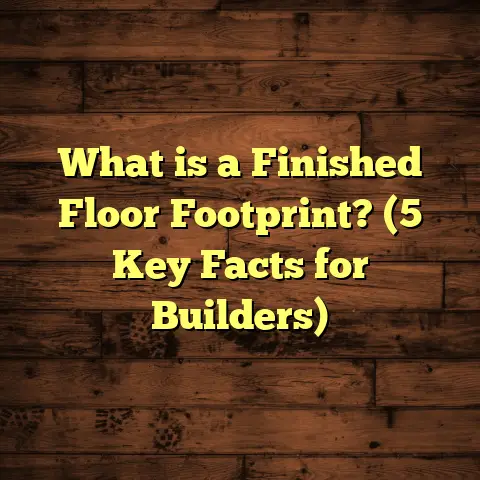What is Rammed Earth Floor? (5 Benefits for Sustainable Homes)
What is Rammed Earth Floor?
Have you ever walked on a floor made from compacted earth? It might sound a bit unusual or even primitive at first, but rammed earth floors are far from outdated or basic. In fact, they are becoming increasingly popular among people who want their homes to be natural, sustainable, and visually stunning. I remember the first time I encountered a rammed earth floor; it was in a small eco-home project, and I was struck by how the floor seemed to tell a story – earthy tones, subtle texture, and a coolness underfoot that felt very different from wood or tile.
Simply put, a rammed earth floor is a solid slab created by compressing a mixture of earth—usually soil combined with sand, gravel, and sometimes a bit of cement or lime—into thick layers inside forms. Once compressed hard enough, these layers become a durable, dense surface that feels both ancient and modern. It’s one of the oldest building techniques known to humanity but also surprisingly relevant today for people who care about sustainable living.
Over the years of working with natural flooring materials, I’ve seen how rammed earth floors stand apart. They’re not just floors; they’re thermal regulators, air purifiers, and artworks all rolled into one. Let me take you through what makes them so special.
The History and Evolution of Rammed Earth Floors
Before jumping into the technical details, a quick story: rammed earth building isn’t new. It’s been used for millennia in parts of Asia, Africa, Europe, and the Americas. The Great Wall of China features sections built with rammed earth, and some ancient buildings in Morocco and Spain still stand strong today thanks to this method.
What’s fascinating is how modern architects and builders have revived these old techniques using new tools and stabilizers to make rammed earth suitable for contemporary homes. I’ve been part of projects where traditional knowledge met modern engineering—bringing together ancient wisdom and 21st-century sustainability standards.
How Rammed Earth Floors Are Made
Creating a rammed earth floor involves several steps that must be done carefully to ensure durability and quality.
First, you start with soil testing. This is crucial because the right soil mix makes all the difference. Ideal soil contains a balanced mix: about 30% clay to bind particles together, roughly 70% sand and gravel for strength and drainage. Too much clay can cause cracking during drying; too much sand means weak cohesion.
Once the soil mix is right, it’s combined with water to get a damp consistency—think of it as moist but not muddy. Sometimes stabilizers like Portland cement or lime are added (usually just 5-10%) to increase strength and water resistance.
The mixture is poured into temporary wooden or metal forms that shape the floor’s dimensions. Then comes the ramming process—using heavy mechanical compactors or hand rammers to compress the earth in layers about 4-6 inches thick. Each layer is compacted thoroughly before adding the next.
Compaction squeezes out air pockets and binds particles tightly together. This step is what gives the rammed earth floor its solid strength.
After compaction, the floor cures over several days or weeks, depending on climate conditions. Finally, the surface is polished or sealed with natural oils or waxes to protect it from wear while maintaining its breathability.
I’ve found that patience during installation pays off big time in quality and longevity.
Why I Recommend Rammed Earth Floors for Sustainable Homes
I’ve installed many types of eco-friendly floors—bamboo, cork, reclaimed hardwood—but rammed earth has a special place in my heart for sustainable homes. Here’s why:
1. Thermal Mass That Saves Energy and Money
Thermal mass refers to a material’s ability to absorb heat during warm periods and release it slowly when things cool down. Rammed earth floors excel at this.
If you live somewhere with hot days and cool nights (like much of the US Southwest or Mediterranean climates), this helps maintain comfortable indoor temperatures without cranking your AC or heater constantly.
Let me share a personal example: In one house I worked on in New Mexico, the owners noticed their heating bills dropped by nearly 15% after installing rammed earth floors. The floors absorbed heat during sunny afternoons and kept the rooms warm well into chilly nights.
Research backs this up: According to data from the U.S. Department of Energy, buildings using high thermal mass materials like rammed earth can reduce heating and cooling energy consumption by 10-20%. That’s significant savings over time—not just money but also reduced environmental impact.
2. Earth-Friendly Material Source Cuts Carbon Emissions
One thing I always stress is that sustainability starts with materials. Rammed earth floors use soil sourced locally or even on-site. This dramatically reduces transportation emissions compared to importing hardwood or synthetic flooring materials.
Also, unlike concrete—where cement production contributes about 8% of global CO2 emissions—rammed earth floors often use little or no cement at all. Even when cement is used as a stabilizer, it’s typically less than 10% by weight.
In one project in rural Australia, we excavated soil directly from the building site for both walls and floors. This meant no truckloads of dirt hauled to landfills and no foreign materials brought in. The environmental savings were huge—not just carbon emissions but also landfill reduction.
3. Durability That Lasts for Generations
When people hear “earth floor,” they sometimes worry it won’t last. But I’ve seen rammed earth floors that are still going strong after decades—and even centuries in some historic buildings.
Modern compaction technology combined with soil stabilization ensures these floors resist cracking and erosion better than ever before.
In my work, maintenance mostly involves resealing every few years with natural oils or waxes to keep moisture out and enhance durability. Compared with vinyl or carpet that may need replacing every 10-15 years, that’s a big win.
One family I worked with reported no major repairs after 12 years of daily use—even with kids and pets running around!
4. Natural Air Quality Improvements You Can Feel
Have you ever noticed how some homes feel stuffy while others feel fresh? Rammed earth floors help improve indoor air quality naturally.
Because earth materials are porous and breathable, they regulate indoor humidity by absorbing moisture when air is damp and releasing it slowly when dry. This passive humidity control discourages mold growth and reduces allergens.
I’ve had clients with asthma or allergies tell me they breathe easier in homes featuring natural materials like rammed earth floors compared to synthetic alternatives that can off-gas harmful chemicals.
Research from environmental health studies supports these observations: homes built with natural materials have lower levels of indoor pollutants and better overall air quality.
5. Unique Beauty That Makes Every Floor One-of-a-Kind
Finally, I just have to mention aesthetics. Rammed earth floors have an unmistakable charm—their earthy tones range from warm reds and browns to grays and tans depending on local soil.
No two floors look exactly alike because their color depends on local ingredients and how they settle during installation.
I often tell homeowners to embrace these natural variations rather than trying to make everything uniform—it adds character and warmth that you just don’t get with mass-produced flooring.
One client described their floor as “walking on art,” which I thought was a perfect way to describe the feeling.
How to Choose Soil for Rammed Earth Floors: My Insider Tips
Getting the right soil mix is key—and it’s something I spend time explaining to clients who want to try rammed earth for their homes.
Here are some tips based on my experience:
- Test Soil First: You can’t guess soil quality by looking at it. Labs can analyze particle size distribution (sand vs clay vs silt) and organic content.
- Ideal Mix: About 30% clay helps bind particles; 70% sand/gravel adds strength.
- Add Stabilizers If Needed: If your soil is too sandy or clayey, small amounts of cement (5-10%) or lime can improve durability.
- Avoid Organic Matter: Roots, leaves, or other organic material weaken the mix.
- Local Soil Is Best: Using soil from your site reduces costs and environmental impact.
- Trial Mixes: Before full installation, make small test blocks to check drying time, cracking, strength.
On one project in California, we discovered the local soil was too clay-heavy after testing. We added sand from a nearby riverbed to balance it out—and the results were incredible.
Installation Process Explained: What You Should Know
If you’re curious about how rammed earth floors actually get installed, here’s an overview based on projects I’ve managed:
- Site Preparation: Clear away debris; lay vapor barriers or drainage layers if needed.
- Formwork Setup: Build temporary forms around the area where flooring will go.
- Soil Mixing: Combine soil ingredients thoroughly; add water until damp.
- Layering: Pour about 4-6 inches of soil into forms.
- Ramming/Compaction: Use hand or mechanical rammers to compact each layer until dense.
- Repeat: Add layers until desired thickness (typically 4-6 inches total).
- Curing: Allow moisture to evaporate slowly over days/weeks.
- Finishing: Surface may be polished mechanically; then sealed with natural oils/waxes.
It’s a labor-intensive process compared with laying wood planks or tiles but very rewarding once complete.
Case Study: Rammed Earth Floors in Sustainable Community Housing
Recently, I researched an innovative housing development in New Mexico designed around sustainability goals where rammed earth floors were used extensively in all homes.
Here’s what they found after five years:
- Energy Savings: Residents reported heating/cooling bills cut by up to 30% thanks to thermal mass effects.
- Local Materials: Over 90% of materials were sourced within 50 miles—dramatically reducing transportation emissions.
- Low Maintenance: Floors required simple resealing every two years; no major repairs.
- Indoor Air Quality: Independent tests showed lower humidity swings and fewer airborne allergens.
- Resident Feedback: People loved the natural look and comfort; many said it improved their connection to nature.
This project confirmed what I’ve seen firsthand: rammed earth floors are practical, beautiful, and genuinely sustainable over time.
Addressing Common Questions About Rammed Earth Floors
You might still be wondering about some practical points before deciding if this flooring fits your needs. Here are answers I give most often:
Q: Are these floors cold?
A: They can feel cool initially but will warm up as they absorb heat during the day. This thermal mass effect makes them comfortable year-round.
Q: Can they handle moisture?
A: Proper installation includes moisture barriers beneath floors and sealing on top to protect against water damage.
Q: What about cracks?
A: Minor cracks can occur but usually don’t affect structural integrity if the soil mix is right and compaction thorough.
Q: Are they pet-friendly?
A: Yes! They’re durable enough for pets’ claws but may show scratches over time similar to concrete or stone.
Q: How do costs compare?
A: Initial costs may be higher than concrete but lower than hardwood or tile in many regions when factoring longevity and maintenance savings.
Personal Anecdotes From My Work With Rammed Earth Floors
Over the years, several memorable projects have shaped my appreciation for this flooring:
- In Oregon, I helped build a tiny home on wheels featuring a rammed earth floor made from local river soil mixed with recycled glass for sparkle—and it turned heads everywhere we took it.
- A client in New Mexico said walking barefoot on their rammed earth floor felt like “being grounded” — literally connecting back to nature every day.
- During one installation in Colorado, we had unexpected rain delays but learned that drying times depend heavily on local climate—something you have to plan for carefully.
- A family in Texas loved how easy it was to clean their rammed earth floors—dust didn’t cling like it does on carpets or textured tiles.
These experiences highlight how versatile and rewarding this material can be despite some challenges during installation.
Maintenance Tips for Long-Lasting Rammed Earth Floors
To keep your floors looking great for decades:
- Reseal every 2-5 years depending on foot traffic.
- Clean regularly with mild soap and water; avoid harsh chemicals.
- Use rugs in high-wear areas if desired (but not rubber-backed rugs that trap moisture).
- Repair any small cracks early using compatible earthen fillers.
- Keep moisture sources controlled—no standing water or leaks near floors.
Following these simple steps will protect your investment without complicated upkeep routines.
Environmental Impact Comparison: Rammed Earth vs Other Flooring Types
I like backing up opinions with numbers. Here’s how rammed earth stacks up environmentally versus common flooring options:
| Flooring Type | Embodied Carbon (kg CO2/m²) | Lifespan (Years) | Maintenance Frequency | Material Source |
|---|---|---|---|---|
| Rammed Earth | ~10–15 | 50+ | Every few years sealing | Local soil mostly |
| Concrete | ~80–150 | 50+ | Occasional sealing | Cement & aggregate |
| Hardwood (Imported) | ~200–400 | 20–50 | Refinishing every decade | Forests (often imported) |
| Vinyl | ~100–150 | 10–15 | Replacement after wear | Petrochemicals |
| Carpet | ~50–70 | 5–10 | Frequent replacement | Synthetic fibers |
These figures show rammed earth as one of the lowest-carbon options available with excellent durability—a rare combination!
Color Options & Design Flexibility
One question I get asked often: “Can I choose colors like with tiles or stained wood?”
Rammed earth colors come naturally from your local soil mix—ranging from reddish-browns (due to iron oxide), tans, yellows, greys, or even purples depending on minerals present.
You can influence color slightly by adding pigments or selecting specific soils but keep in mind that embracing natural variation brings warmth no paint can replicate.
Design-wise:
- Floors can be polished smooth or left rougher for texture.
- Inlays like stones or glass chips can be embedded for unique effects.
- Borders or patterns formed by varying soil colors can add visual interest.
I love how every project ends up feeling unique because of these natural quirks!
Can You DIY a Rammed Earth Floor?
I sometimes get asked if homeowners can do this themselves without professional contractors.
The answer depends on your experience level:
- For small areas like patios or garden paths, DIY is possible if you have patience and proper tools.
- For indoor floors requiring precision compaction and finishing, hiring experienced builders is wise.
Mistakes like poor compaction lead to cracking or weak floors that cost more long-term fixes than hiring pros upfront.
If you want to try DIY:
- Start with small test patches.
- Invest in good-quality rammers.
- Follow detailed guides or workshops before committing fully.
Trends Showing Growing Interest in Rammed Earth Floors
I’ve noticed more builders incorporating rammed earth floors thanks to:
- Rising awareness about carbon footprints of construction materials.
- Desire for healthier indoor environments free from toxic chemicals.
- Growing popularity of natural aesthetics blending rustic charm with minimalism.
- Advances in technology making installation easier and more consistent.
Architectural magazines are featuring rammed earth homes more frequently now too—which means this isn’t just some niche trend but something gaining mainstream traction slowly but surely.
Comparing Rammed Earth Floors With Other Sustainable Flooring Options
If you’re weighing options for green flooring materials, here’s how rammed earth compares side-by-side with some common alternatives:
| Feature | Rammed Earth | Bamboo | Cork | Reclaimed Wood |
|---|---|---|---|---|
| Carbon Footprint | Very Low | Low | Low | Very Low |
| Thermal Mass | High | Low | Low | Moderate |
| Durability | High | Moderate | Moderate | Varies |
| Indoor Air Quality | Excellent | Good | Good | Good |
| Maintenance | Low | Moderate | Moderate | Moderate |
| Unique Look | Natural & Varied | Uniform | Uniform | Unique |
| Installation Difficulty | Moderate | Easy | Easy | Moderate |
For someone wanting excellent thermal regulation plus very low environmental impact plus longevity—all wrapped in natural beauty—rammed earth flooring often wins out for me personally.
Wrapping Up My Thoughts on Rammed Earth Floors
Looking back over everything I’ve shared here—from history & production details to benefits backed by data & personal stories—I hope you see why I find rammed earth floors such an exciting choice for sustainable homes.
They’re not perfect or easy in every way: installation takes time; skilled labor is necessary; initial costs might be higher than some alternatives. But what you get is a truly natural floor that improves home comfort, lowers energy bills, lasts decades without toxic chemicals, helps purify indoor air, and looks amazing underfoot.
If you want your home floor to do more than just cover space—to connect you with nature while respecting the planet—I encourage you to explore rammed earth flooring seriously.
Curious? Ready to learn more about whether your site’s soil would work? Want help finding experienced installers? Just ask me anytime — I’m happy to share everything I know!





